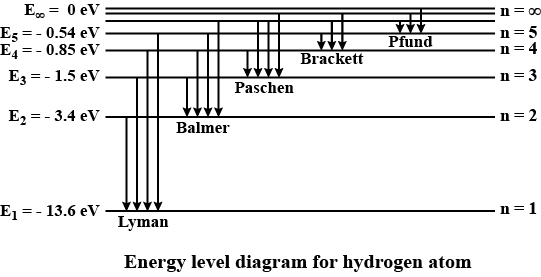
Draw a neat labeled energy level diagram and explain the different series of spectral lines for the hydrogen atom.
Answer
566.7k+ views
Hint: The electrons are transited from higher energy level to the lower energy levels. This causes the spectral lines of different wavelengths. The single electron orbiting around the nucleus of the hydrogen atom is explained by the Bohr model of the atom.
Complete step by step answer:
The energy level diagram of the hydrogen atom is given below.

When the electron transits from a higher energy level to a lower energy level photon is emitted. The energy of the photon is the difference in the energy of the states. The photon will emit with a frequency corresponding to the energy difference of the final and initial energy states. The energy of each state remains the same. Hence the emitted photon will always have the same frequency always.
The spectral lines are classified into series. The expression connecting the wavelength and the difference between the energy levels is described by the Rydberg formula.
$\dfrac{1}{\lambda } = {Z^2}R\left( {\dfrac{1}{{n_f^2}} - \dfrac{1}{{n_i^2}}} \right)$.
Where $\lambda $ is the wavelength, $Z$ is the atomic number, $R$ is the Rydberg constant, ${n_f}$ is the principal quantum number of the final state, and ${n_i}$ is the principal quantum number of the initial state.
The spectral lines including the transition of the electron to $n = 1$ energy state from the higher energy levels are called Lyman series. That is ${n_f} = 1$ and ${n_i} > 1$.
The spectral lines including the transition of the electron to $n = 2$ energy state from the higher energy levels are called Balmer series. That is ${n_f} = 2$ and ${n_i} > 2$.
The spectral lines including the transition of the electron to $n = 3$ energy state from the higher energy levels are called Paschen series. That is ${n_f} = 3$ and ${n_i} > 3$.
The spectral lines including the transition of the electron to $n = 4$ energy state from the higher energy levels are called Brackett series. That is ${n_f} = 4$ and ${n_i} > 4$.
The spectral lines including the transition of the electron to $n = 5$ energy state from the higher energy levels are called Pfund series. That is ${n_f} = 5$ and ${n_i} > 5$.
Note:
The wavelength will be higher for the transitions between adjacent energy levels. The Balmer series have wavelengths similar to the visible light. Hence they are visible. And the Paschen lies in the infrared region.
Complete step by step answer:
The energy level diagram of the hydrogen atom is given below.

When the electron transits from a higher energy level to a lower energy level photon is emitted. The energy of the photon is the difference in the energy of the states. The photon will emit with a frequency corresponding to the energy difference of the final and initial energy states. The energy of each state remains the same. Hence the emitted photon will always have the same frequency always.
The spectral lines are classified into series. The expression connecting the wavelength and the difference between the energy levels is described by the Rydberg formula.
$\dfrac{1}{\lambda } = {Z^2}R\left( {\dfrac{1}{{n_f^2}} - \dfrac{1}{{n_i^2}}} \right)$.
Where $\lambda $ is the wavelength, $Z$ is the atomic number, $R$ is the Rydberg constant, ${n_f}$ is the principal quantum number of the final state, and ${n_i}$ is the principal quantum number of the initial state.
The spectral lines including the transition of the electron to $n = 1$ energy state from the higher energy levels are called Lyman series. That is ${n_f} = 1$ and ${n_i} > 1$.
The spectral lines including the transition of the electron to $n = 2$ energy state from the higher energy levels are called Balmer series. That is ${n_f} = 2$ and ${n_i} > 2$.
The spectral lines including the transition of the electron to $n = 3$ energy state from the higher energy levels are called Paschen series. That is ${n_f} = 3$ and ${n_i} > 3$.
The spectral lines including the transition of the electron to $n = 4$ energy state from the higher energy levels are called Brackett series. That is ${n_f} = 4$ and ${n_i} > 4$.
The spectral lines including the transition of the electron to $n = 5$ energy state from the higher energy levels are called Pfund series. That is ${n_f} = 5$ and ${n_i} > 5$.
Note:
The wavelength will be higher for the transitions between adjacent energy levels. The Balmer series have wavelengths similar to the visible light. Hence they are visible. And the Paschen lies in the infrared region.
Recently Updated Pages
A man running at a speed 5 ms is viewed in the side class 12 physics CBSE

The number of solutions in x in 02pi for which sqrt class 12 maths CBSE

State and explain Hardy Weinbergs Principle class 12 biology CBSE

Write any two methods of preparation of phenol Give class 12 chemistry CBSE

Which of the following statements is wrong a Amnion class 12 biology CBSE

Differentiate between action potential and resting class 12 biology CBSE

Trending doubts
What are the major means of transport Explain each class 12 social science CBSE

Which are the Top 10 Largest Countries of the World?

Draw a labelled sketch of the human eye class 12 physics CBSE

How much time does it take to bleed after eating p class 12 biology CBSE

Explain sex determination in humans with line diag class 12 biology CBSE

Explain sex determination in humans with the help of class 12 biology CBSE




